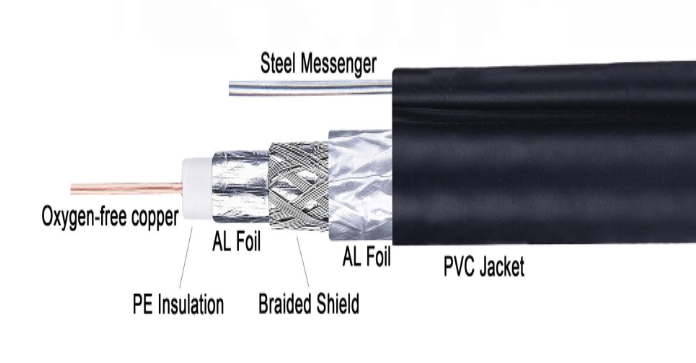
What is the Difference Between RG8 and RG11?
In the world of cable connections, RG8 coaxial cable has gained immense popularity for its superior performance and reliability. Whether you're a professional in the cable industry or a curious enthusiast, understanding the features, applications, and key differences of RG8 cable is essential.
In this post, we will delve into the details of RG8 coaxial cable, its uses, and how it differs from other commonly used cables like coaxial cable RG11 and RG58.
What is RG8 Coaxial Cable?
RG8 coaxial cable is a versatile and robust transmission medium widely used in various industries, including telecommunications, broadcasting, military applications, and more. It consists of a central conductor, dielectric insulator, shield, and outer jacket.
The central conductor carries the electrical signal, while the dielectric insulation ensures minimal signal loss. The shield provides protection against electromagnetic interference (EMI) and the outer jacket shields the cable from physical damage. Understanding the coaxial cable manufacturing process helps appreciate the precision involved in creating these layers to ensure optimal performance.
What is RG8 Cable Used For?
RG8 coaxial cable is well-suited for applications that require efficient signal transmission over long distances while maintaining signal integrity. Here are some common uses of RG8 cable:
High-Frequency Communications RG8 cable excels in transmitting high-frequency signals, making it ideal for applications such as long-range radio communications, amateur radio (HAM) setups, and data transmission in broadcasting.
Ethernet and Data Networks RG8 cable is employed in data networks, especially when longer cable runs are necessary, providing reliable connectivity for high-speed data transfer, video streaming, and other bandwidth-intensive tasks.
Antenna Systems Due to its low loss characteristics and high power handling capability, RG8 cable is commonly used in antenna systems for TV broadcasting, radio stations, and cellular base stations, ensuring optimal signal quality and coverage.
Military and Aerospace The rugged construction of RG8 cable makes it suitable for military and aerospace applications, including radar systems, satellite communications, and defense equipment, where durability and signal integrity are crucial.
What is the Difference Between RG8 and RG11?
While both RG8 and RG11 coaxial cable with steel shielding fall under the RG (Radio Guide) series of coaxial cables, they have distinct characteristics that make them suitable for different applications:
Signal Loss RG11 has a lower loss compared to RG8, making it better for longer cable runs. It offers superior signal transmission over extended distances, making it suitable for distributing signals in cable television (CATV) networks and long-distance data transmission.
Diameter and Thickness RG11 has a larger diameter and thicker conductor compared to RG8, resulting in improved signal-carrying capacity. This allows RG11 to handle higher frequencies and greater power levels.
Cost RG11 cable is generally more expensive than RG8 due to its larger size and enhanced performance. However, for applications where signal loss and distance are critical factors, the investment in RG11 can be worthwhile.
What is the Difference Between RG8 and RG58 Cable?
RG58 cable is another commonly used coaxial cable, but it differs from RG8 in several aspects:
Size and Flexibility RG58 is thinner and more flexible than RG8. Its smaller diameter and lightweight construction make it suitable for applications where space and maneuverability are limited, such as computer networking, video surveillance, and shorter cable runs.
Signal Loss and Distance RG8 outperforms RG58 in terms of signal loss and transmission distance. RG8 is better suited for applications that require longer cable runs and higher signal fidelity, whereas RG58 is more suitable for shorter distances.
Frequency Range RG8 has a broader frequency range compared to RG58, making it better suited for high-frequency applications that demand wider bandwidth, such as high-speed data transmission and radio frequency (RF) communication.
Power Handling RG8 has a higher power handling capacity than RG58. It can handle greater power levels without significant signal degradation, making it suitable for applications that require high-power transmission, such as amplifiers and transmitters.
Additional Considerations: Connectors and Manufacturing
When working with RG8 or RG11 cables, selecting the right connectors is crucial for maintaining signal quality. There are many coaxial cable connector manufacturers specializing in connectors compatible with these cables, ensuring secure and reliable connections.
Moreover, the coaxial cable manufacturing process involves precise layering and shielding techniques, including the use of steel in RG11 coaxial cable for enhanced durability and shielding effectiveness. This manufacturing quality directly impacts the cable's performance in demanding environments.
Conclusion
RG8 coaxial cable is a reliable and versatile transmission medium widely used in various industries due to its excellent signal transmission capabilities and durability. With its ability to handle high-frequency signals over long distances, RG8 is well-suited for applications in telecommunications, broadcasting, military, and other sectors.
So, whether you're setting up a communication network, installing antennas, or working on a military project, RG8 coaxial cable offers a robust solution for your transmission requirements.







Leave a comment